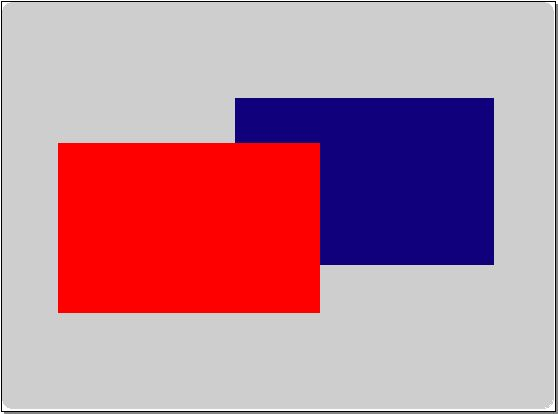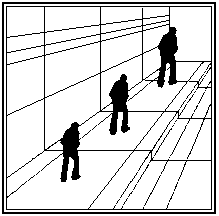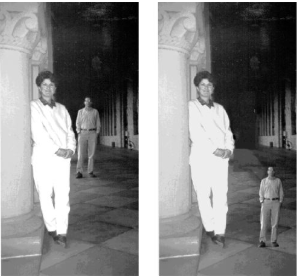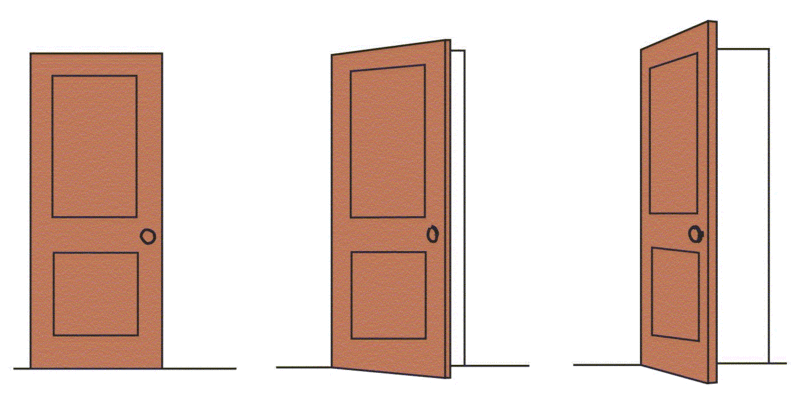perception, senses, sleep/consciousness, drugs
1/505
Earn XP
Name | Mastery | Learn | Test | Matching | Spaced |
|---|
No study sessions yet.
506 Terms
visual cues
depth, form, motion, constancy
allows us to perceptually organize information
binocular cues
depth cues, such as retinal disparity and convergence, that depend on the use of two eyes
retinal disparity
a binocular cue for perceiving depth by comparing images from the retinas in the two eyes, the brain computes distance—the greater the disparity (difference) between the two images, the closer the object.
eyes are how far apart from each other?
2.5 inches
convergence
A binocular cue for perceiving depth; the extent to which the eyes converge inward when looking at an object
eyes when things are far away
muscles of eyes are relaxed
eyes when things are close to us
muscles of eyes contract
monocular cues
depth cues, such as interposition and linear perspective, available to either eye alone
biocular cues give us a sense of
depth
monocular cues give us a sense of
form and motion
relative size
a monocular cue for perceiving depth; the smaller retinal image is farther away

Interposition
overlap
monocular visual cue in which two objects are in the same line of vision and one partially conceals the other, indicating that the first object concealed is further away

relative height
a monocular cue for perceiving depth; objects higher in our field of vision are perceived as farther away

shading/contour
a monocular cue for depth perception; the apparent light source determines whether the surface of an object is perceived as concave or convex

motion parallax
relative motion
a monocular depth cue in which we view objects that are closer to us as moving faster than objects that are further away from us

constancy
the tendency to perceive certain objects in the same way regardless of changing angle, distance, or lighting
types of constancy
size, shape, color
size constancy
the tendency to interpret an object as always being the same actual size, regardless of its distance

shape constancy
the tendency to interpret the shape of an object as being constant, even when its shape changes on the retina

color constancy
perceiving familiar objects as having consistent color, even if changing illumination alters the wavelengths reflected by the object (diff colors)

sensory adaptation
tendency of sensory receptor cells to become less responsive to a stimulus that is unchanging
hearing adaptation
inner ear muscle: higher noise = muscle contract (this dampens vibrations in inner ear, protects ear drum.)
Takes a few seconds to kick in! So does not work for immediate noises like a gun shot, but it works for being at a rock concert for an entire afternoon
touch adaptation
temperature receptors desensitized over time
smell adaptation
desensitized receptors in your nose to molecule sensory information over time.
proprioception
sensory information concerning body movements and position of the body in space
sight adaptation
down regulation or up regulation to light intensity
down regulation in eyes
light adaptation
when it is bright out, pupils constrict and rods and cones become desensitized
pupils constrict
less light enters back of eye
up regulation
dark adaptation
pupils dilate - rods and cones start synthesizing light sensitive molecules
Weber's Law
the principle that, to be perceived as different, two stimuli must differ by a constant minimum percentage (rather than a constant amount)
just noticeable difference (JND)
the smallest change in the intensity of a stimulus that we can detect
Weber's law formula
JND= K x I
K = constant
I = initial intensity
Absolute threshold of sensation
minimum intensity of stimulus needed to detect a particular stimulus 50% of the time
difference threshold
the minimum difference between two stimuli required for detection 50 percent of the time
subliminal stimuli
stimuli that are below the level of conscious awareness
types of somatosensation
thermoception, mechanoception, nociception, proprioception
Somatosensation
The body senses, including body position, touch, skin temperature, and pain.
thermoception
temperature perception
mechanoception
sensation of pressure
Proprioception
The ability to tell where one's body is in space.
Nociception
perception of pain
intensity
how quickly neurons fire for us to notice
slow neuron firing
low intensity
fast neuron firing
high intensity
non adapting neuron
neuron consistency fires at a constant rate
slow adapting neuron
neuron fires rapidly at first then tapers off
fast adapting neuron
fires as soon as stimulus starts, stops, then starts up again once stimulus stops
dermatomes
an area of the skin supplied by nerves from a single spinal root
vestibular system
three semicircular canals that provide the sense of balance, located in the inner ear and connected to the brain by a nerve
semicircular canals
three canals within the inner ear that contain specialized receptor cells that generate nerve impulses with body movement
endolymph
fluid within the membranous labyrinth of the inner ear
otolithic organs
Utricle and saccule. Detect linear acceleration and head positioning
otolithic organs detect
linear acceleration
otolithic organs contain
CaCO3 crystals attached to hair cells in vicious gel
if we go from lying down to sitting up:
otolithic organs pull on hair cells which triggers AP
dizziness is caused by
endolymph continuing to move after you've stopped moving
signal detection theory
the response to a stimulus depends both on a person's sensitivity to the stimulus in the presence of noise and on a person's response criterion
hit
the subject responded affirmative when a signal was present
miss
subject did not respond when a signal was present
false alarm
the subject perceived a signal when none was present
correct rejection
the subject did not respond when no signal was present
hit > miss
strong signal
hit < miss
weak signal
conservative strategy
always say no unless 100% sure signal is present. Bad thing is might get some misses
liberal strategy
always say yes, even if you get false alarms.
noise distribution
The distribution of possible neural responses to a trial on which no stimulus is present.
signal distribution
values arising when signal + noise present
Ideal observer to signal detection
Difference between signal and noise = d'
d'/2 = ideal observer (maximize hits minimize misses)
difference between signal and noise
d'
if signal is shifted to the left, d' is very small and difficult to detect
if shifted right, it's large and easy to detect
ideal observer
minimizes misses and false alarms
Beta strategy
Set value of threshold to the ratio of height of signal distribution to the height of noise distribution
bottom-up processing
analysis that begins with the sensory receptors and works up to the brain's integration of sensory information
top-down processing
information processing guided by higher-level mental processes, as when we construct perceptions drawing on our experience and expectations
inductive reasoning
A type of logic in which generalizations are based on a large number of specific observations.
deductive reasoning
reasoning in which a conclusion is reached by stating a general principle and then applying that principle to a specific case (The sun rises every morning; therefore, the sun will rise on Tuesday morning.)
Gestalt Principles
ways for the brain to infer missing parts of a picture when a picture is incomplete
similarity
items that are similar tend to be grouped together
Pragnanz
reality is reduced to the simplest form possible (eg Olympic rings)
proximity
objects that are close together are more likely to be perceived as belonging in the same group
continuity
lines are seen as following the smoothest path
closure
objects that make up a recognizable image are more likely to be perceived as belonging in the same group even if the image contains gaps that the mind needs to fill in
symmetry
mind perceives objects as being symmetrical and forming around a center point
law of common fate
The Gestalt principle that we tend to group similar objects together that share a common motion or destination
Law of Past Experiences
Implies that under some circumstances visual stimuli are categorized according to past experience.
contextual effects
the context in which stimuli are presented and the processes of perceptual organization contribute to how people perceive those stimuli (and also that the context can establish the way in which stimuli are organized)
conjuctiva
thin layer of cells
mucous membrane that lines the eyelids and outer surface of the eyeball
cornea
the transparent thick sheet of fibrous tissue
anterior 1/16th
starts to bend light; first part of eye that light hits
anterior chamber
Area behind the cornea and in front of the lens and iris. It contains aqueous humor.
aqueous humor
provide pressure to maintain shape of eyeball
allows nutrients and minerals to supply cells of cornea/iris
pupil
the opening in the middle of the iris that changes size to let in different amounts of light
iris
muscle that expands and contracts to change the size of the opening (pupil) for light
iris does what?
gives the eye color
lens
bends light so it goes to back of eyeball - focuses light specifically on the fovea of the retina. Adjust how much it bends the light by changing its shape, using the suspensory ligaments.
suspensory ligaments
a fibrous membrane that holds the lens of the eye in place
suspensory ligaments are attached to
ciliary muscle
ciliary muscle
muscle that helps focus light on the retina by controlling the curvature of the lens of the eye
ciliary body
Structure surrounding the lens that connects the choroid and iris. It contains ciliary muscles, which control the shape of the lens, and it secretes aqueous humor.
posterior chamber
area behind the iris to the back of lens; also filled with aqueous humor.
vitreous chamber
the main interior portion of the eye, filled with vitreous humor
vitreous humor
jelly-like substance to provide pressure to eyeball and gives nutrients to inside of eyeball.